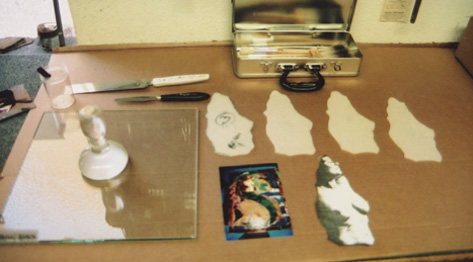
millenniumartglass.com
Millennium Art Glass Company
(A division of fruitcratelabels.com)
Page 4) MERMAIDS, GLASS PAINTING,
NEW KILN AND
DIANNA THE HUNTRESS (DRAPERY GLASS)
*NOTE: Today, it is almost 2008, and I am fully hooked by glass! I am gathering estates of scrap glass and watching garage sales and newspaper ads for people selling glass. So if you have large quantities of scrap you no longer want, I would be interested in seeing it. I have quite a bit of Spectrum, and am seeking Uroburos, Kokomo, Bullseye, Chicago, older Oceana, and extinct glass from decades past, especially hand rolled glass, and glass from glass-making companies no longer in business. I am particularly interested in unusual colors and textures, all colors are fine, opaque is better than clear generally, for my uses. Some windows I do in the future,I will post online, other designs I probably won't, to reduce piracy of the designs. All my personal designs are coprighted, including those on this page, except for "The Pool" which is someone else's design I used for a class project. I have a dozen other propietary designs in the works and lined up for production. I plan to do some pattern books as well. But, just for fun, I am recording the different steps along the way with this web site. I have about 50-60 designs ready to go, and I will display them here. Please don't use them without permission :)
BACK TO THE TWIN MERMAIDS WINDOWS SAGA... and then some.
It now the first of November 2007, a year after my friend posed for her window, and seven months since the PATINA DISASTER which temporarily derailed my glass career. But, now I am ready to rebuild and move on. So....., I spend many nights trying to re-paint the pieces that had been damaged, and found it very frustrating. I think it is comparable to building a house, and having it burn down the night before you move in. After the smoke clears you say to yourself, "I don't WANT to do this again, I think I will get some help." At this point it has been a year since my friend posed for her window <art-glass2.html> , and seven months since the disaster with the patina. My wife and I decided that it would be best to send the pieces to Raphael and let him restore them, so I could put this whole event behind me. "Sometimes it is best just to hire a professional so you may move on..." she said, "and Raf has forty more years of experience than you do." I had to agree. So, I sent the pieces to Raf for restoration, but still worked on a couple sets of torsos I had here. So I spent a few evenings working on them, and remaining frustrated with my results. Even though I had done this successfully once, and can do it again, I think I just need to move on. So, instead, I set them aside and started another aspect of my training. One of my dear friends said " you NEVER want to advertise your failures"... but I felt it more important to share this with everyone, rather than be stoic and clandestine. My work will be "what it is" either way.

I decided to stop focusing on ONE project and dive into learning about my kiln, various paints, ultraviolet lights and "tinned" sides of glass, and so on. So, I brought a light table up to my garage and set it on the work bench. Then, I took 15-20 pieces of clear float glass, and laid them over a bunch of various photographs and sketches of images I wanted to experiment with on glass. I "sized" the glass to the images and lightly taped the images down, then the glass over it. Then I mixed up some black tracing paint, grabbed a brush and started outlining all of them. Since my current focus in painting on glass is the human form, I started with several such images from travel magazines, art-books and so on. The tracing process was pretty easy. Because the pieces were bigger than my kiln shelf, I had to fire them in two different firings. So, I called Phil Teefy to get a firing schedule for the kiln, and then learned to kiln-wash the shelf. Then I put a batch of the tracings on the kiln shelf, closed the lid and set the controller to "do its thing." Over the next two evenings, I fired all the pieces. My only problem, is spending too much time selling labels and surviving, and NOT having enough time to focus on glass work!
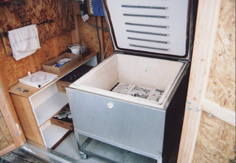
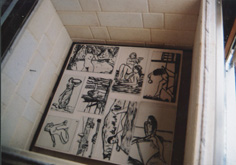
Over the course of a week or two, I continued to add colors of FuseMaster Low-Fire enamels to the different pieces, and re-fire them. By this time, I had spent the past year studying painting on glass, and bought several books on the subject, including Albinas Elskus' "The Art of Painting on Glass" and the Seymours' and Dick Millard's work, "Stained Glass Painting," and Peter McGrain's books and videos.I also learned from small sections in many other books, as well as hunting-around on the Internet. I went to Reusche's website and FuseMaster's and got their catalogues and read all I could find. I called several glass painters I found on google and asked about paints and kilns, and they were all happy to answer my questions. I also asked Raphael a LOT of questions. When I had studied painting in Portland, I was warned away from lead-based enamels due to toxicity issues. So, before learning about those (which I intended to do), I bought a starter kit of colors from FuseMaster, just the basic four or five. And, a "kit" with a set of brushes and three colors from Peter McGrain. Then one evening, Phil at Rainbow glass shared with me some Reusche colors, I got 11 different all containing lead. Also, some glass stain. I knew there were toxicity issues with these, so I looked up "lead" on google and learned about being careful around it. I also read on three glass forums (blogs), eveything I could find, before I dug-in and worked with these different paints. I bit the bullet ($200.) and bought all 24 colors of FuseMaster's LO series, lead-free low fire enamels. THAT was what I was waiting for.
I related the story to someone: " I took 20 small pieces of float glass, determined the tin side with a black light, and found 20 or so images I liked. I put them all on a light table together and one evening mixed some trace black and started outlining all of them. I fired them all and then came back the next evening and mixed up some blue and put "water" on the images with water scenes, and yellow for blond hair on a couple of the feminine images, and red on some clothes, brown for trees,and so forth. Then i fired them again. For two weeks I repainted and re-fired and developed them in simple terms. Once I had that working comfortably, I sat for a couple nights a re-read all about matting. Then I focused on that for a week." One point of view taken by the classical painters on glass is that glass should not be used as a canvas, but rather, colored glass should be "assisted" by paints to enhance it's innate color and qualities. I find, however, that modern painting on glass allows for both schools of thought.
My first basic experiments were quite satisfying to me, and even though I did not finish them all , I learned enough about the characteristics of my kiln, the firing program, the paints, the binders and vehicles and brushes and so on, to feel I had iat least introduced myself to them all in a solid way. I may finish these later, but decided that once I had a few weeks of woring on CLEAR glass, the real lessons would be learned on COLORED or stained glass, because it so so much more vital, and the variables are a world unto themselves. This includes painting on clear glass and layering it over stained glass to get two effects at once!
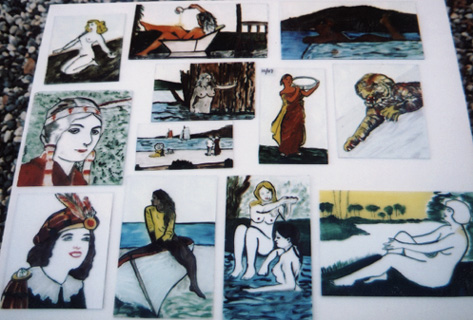
I went on to tell my friend..."Today, I have 50 colors of paints, mostly fusemaster opaques, but also lead-bearing Reusche transparents. I have painted tracelines, matting, stippled, airbrushed and worked on 20 images on glass and done 15 firings or so. I kept calling people and re-reading what to expect, from the books. And, although I am still a total beginner, those several weeks were like a crash course. I learned a lot, including some colors darken when re-fired several times. Others fade. I learned that ring mottles dectrystalize when fired, and change their look entirely. My results after this short test period... I now feel very confident with the paints and mixing, and the mediums and brushes, and feel I am ready to move up to tougher challenges. There are other paints like Drakenfeld, Paradise, and some enameler's China colors and many others, each with their own foibles, requirementss, safety issues, firing quirks and characteristics, which I may end up studying and using in the future. But for now, the set of 24 FuseMaster colors offer a huge pallat. They are all mixable with each other and fire at the same heat. I also found 24 pieces of 1/4" plate glass, 12" x 12" and made a pallat rack for them. Each one has a color on it and some tape telling what it is. That way I can pull out any color at any moment, drop some water on it, mix it, paint and put it away to dry, and grab another. The whole point for me, was to not be timid about it, but to get a bunch of glass, a bunch of paint(s), some brushes, and go for it. I am really excited now and applying what I have learned to my new windows."
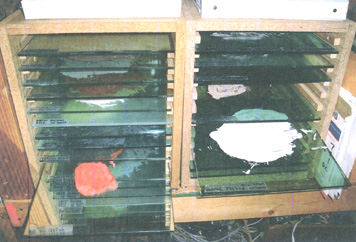
Here is my Pallet rack of paints. And, below is the canvass of a nude I
created with trace lines and a very few colors.
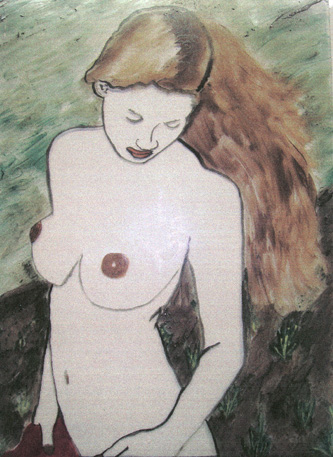
IT WAS A REVELATION TO DISCOVER PAINTING ON GLASS, AS A METHOD FOR BRINGING
ART TO GLASS IN A WAY THAT WAS BOTH CLASSICAL AND CONTEMPORARY. This piece,
was created with trace black and four colors in four firings. was one of
my first experiments with painting on glass as a canvas, and I was happy
with the primative results, enough so, that I felt it was time to move on
to my next project in late November, one that would incorporate many aspects
of the stained glass art.
"DIANA - THE HUNTRESS"
This is my new project in November 2007. Years ago, I was given an artwork
by a career illustrator who worked at one of the lithograph companies I
had studied in my fruit crate label business. The following window of "Diana
- The Huntress" would be another experiment in multi-media glass work.
I started the project with a cartoon on a light table and cut all the pieces
of glass for the design. This included Uroboros drapery glass for the robes,
and several ring-mottled glasses for the surrounding rocks and plants, and
then some Spectrum Irridized blue sky.

The next step was to paint on the glass, the leaves of the surrounding plants and fire them in the kiln. Some of the lower plants were painted on clear Lamberts Restoration clear, and then layered (plated) over ring-mottled glass. This photo is of the results of those steps. (Note that in firing the left hand border for the few leaves, the color of the parent glass changed to a bloody red which no longer matched the un-fired top border made of the same glass. I like the dynamic, so I wil leave it.)
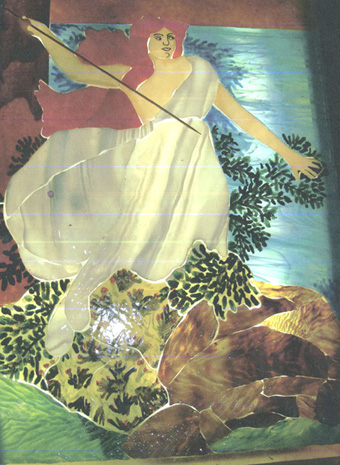
The next step was to copper-foil all the pieces. The spear is layed atop the window with a bamboo skewer right now, which will be replaced with a copper wire and a stone spear-tip later. There are still a couple lof layers of paint needed to establish the shading on the torso and arms. Using all these types of heavily rolled glass, drapery and ring-mottles, required my favorite tool a Taurus III ring saw. A lot of work remains on several aspects of the window, including further painting, plating, and patina.
This page is getting too big, so onto the next page to see how this turned out. <Next Page>
Thomas P. "Pat" Jacobsen --
P.O. Box 791, Weimar, CA, 95736-0791, U.S.A.
Phone 530.637.5923. (8:00 AM - 5:00 PM, weekdays (PST) !!)
EMAIL: pjacobsen@millenniumartglass.com
(Last update: 12/07)